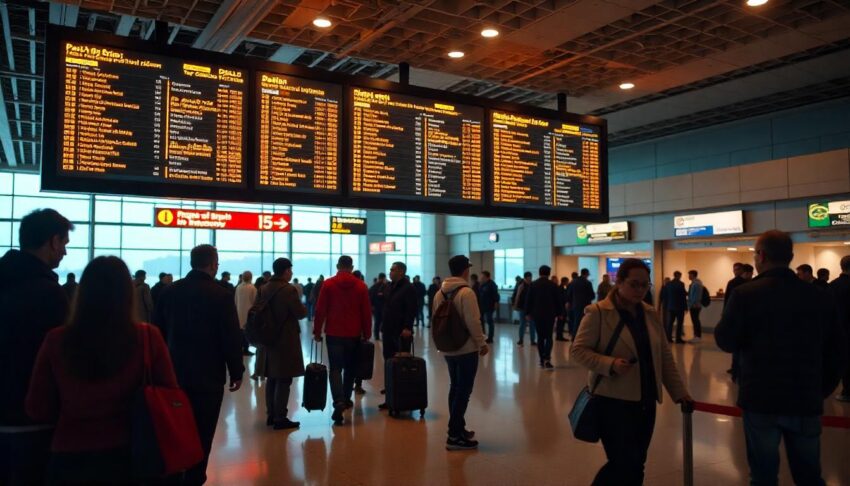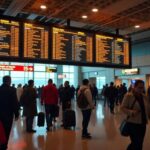Air travel across Asia has been thrown into disarray as over 750 flight delays and cancellations have affected major airlines and airports. The disruptions, impacting carriers such as Singapore Airlines, Japan Airlines, Thai Airways, Emirates, and others, have been reported at key hubs including Jakarta, Kagoshima, Osaka, Bangkok, Sultan Hasanuddin, and Tokunoshima. These operational challenges are primarily attributed to air traffic control issues, crew shortages, and technical difficulties.
The widespread travel interruptions have left thousands of passengers stranded or facing significant delays as airlines and airports struggle to manage the situation. The combination of these factors has created a perfect storm, affecting both international and regional flights across the continent.
Air Traffic Control and Crew Shortages: A Growing Concern
The current disruptions highlight ongoing issues within the aviation industry, particularly concerning air traffic control and staffing shortages. According to industry experts, these problems have been exacerbated by the rapid recovery in air travel demand post-pandemic, which has outpaced the industry’s ability to scale up operations effectively.
At Jakarta’s Soekarno-Hatta International Airport, the situation is particularly severe, with 364 delays and 21 cancellations reported. Airlines such as Batik Air and Garuda Indonesia are among the most affected, with significant portions of their flights delayed. Operational inefficiencies and staffing challenges are cited as primary reasons for the disruptions.
Kagoshima and Osaka: Weather and Operational Constraints
Kagoshima Airport has reported 28 delays and 61 cancellations, with regional carriers like Japan Air Commuter and Japan Airlines experiencing the brunt of the impact. The operational disruptions are further compounded by inclement weather conditions, which have hindered air traffic management.
Meanwhile, Osaka International (Itami) has experienced 73 delays and 12 cancellations. Airlines such as Japan Airlines and Ibex have faced delays due to air traffic control disruptions and operational inefficiencies. While cancellations are relatively few, the delays are widespread across both domestic and international routes.
Impact on Passengers and Airlines
The operational disruptions have caused significant inconvenience for passengers, many of whom are left waiting at airports with limited information on when their flights might depart. The situation has prompted airlines to issue apologies and work on rebooking affected passengers. However, the sheer volume of delays and cancellations has stretched resources thin, leading to longer wait times for customer service and rebooking options.
By the Numbers:
- Kagoshima Airport: 28 delays, 61 cancellations
- Jakarta-Soekarno-Hatta International: 364 delays, 21 cancellations
- Sultan Hasanuddin International: 105 delays, 14 cancellations
- Osaka International (Itami): 73 delays, 12 cancellations
- Suvarnabhumi Bangkok International: 147 delays, 7 cancellations
- Tokunoshima Airport: 5 cancellations
Expert Opinions and Industry Response
Industry analysts suggest that the current disruptions are a wake-up call for the aviation sector to invest more in infrastructure and workforce training. “The rapid rebound in air travel has exposed vulnerabilities in the system that need urgent attention,” says aviation expert Dr. Emily Tan. “Airlines and airports must collaborate to enhance operational efficiency and ensure adequate staffing levels to meet demand.”
Airlines are also urged to improve communication with passengers during such disruptions. Clear and timely information can help manage expectations and reduce frustration among travelers.
Future Implications and Steps Forward
The ongoing disruptions underscore the need for strategic investments in air traffic management systems and workforce development. As the industry continues to recover from the pandemic’s impact, airlines and airports must prioritize resilience and adaptability to handle future challenges effectively.
For passengers traveling through affected airports, it is advisable to stay updated with their airlines for the latest information on flight statuses. Considering alternative routes or rebooking flights may also be necessary to minimize travel disruptions.
As airlines work to resolve these operational issues, the current situation serves as a reminder of the complexities involved in managing modern air travel. The industry’s ability to adapt and innovate will be crucial in preventing similar disruptions in the future.
























